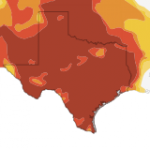How the Midwest Drought is Affecting a Still-Recovering Texas

Photo by SAUL LOEB/AFP/GettyImages
Rotting corn damaged by severe drought on a farm near Bruceville, Indiana last week. Record heat throughout the US farm belt states have curtailed crop production and likely will send corn and soybean prices to record highs, according to the US Department of Agriculture.
It’s a sad irony that just as much of Texas has pulled out of exceptional drought, the rest of the country has entered into it. But even though the severely dry weather is now outside of Texas’ borders, that doesn’t mean the state isn’t feeling the effects.
Remember last year when the Texas drought forced ranchers to sell off their herds or ship cattle to parts of the country where there was enough hay to feed them?
Well, times have changed.
“A lot of those cattle that went up north last year are now heading back south,” says Bexar County Agrilife Extension agent Brian Davis.
When you look at a map of the drought in the U.S. this summer, it almost looks like last year’s weather pattern is turned on its head. The entire middle part of the country is suffering through something much like what Texas suffered through last year. And what do they grow in the middle part of the country? Well, among other things, corn. And it turns out that corn is key to understanding how drought in the Midwest is affecting Texas. Not to sound too insensitive about it, but, in a certain way, their loss is our gain.
“Corn production is up,” Davis says. “We’re seeing above average on the bushel weights coming out of the fields and the prices are looking better than they had in the past.”
It’s simple supply and demand. With the Midwest in drought, corn and other crops are a valuable commodity this year.
“If you have water, obviously when the commodity prices are up, you’re going to take advantage of that,” says Chuck Ahrens, the vice president of Water Resources and Conservation with the San Antonio Water System.
But Ahrens says what’s good news for farmers is not necessarily good for nearby cities, like his. Because farmers are planting more crops later in the season around San Antonio, the aquifer the city relies on depleted faster than anyone expected over the last few weeks, though it did make a significant comeback after recent rains.
“Anytime the aquifer is dropping at a rate that’s not usual, it’s certainly a concern. However, those farmers have permits that are issued to them in a lawful manner and it’s their right to use that water,” Ahrens said.
The corn connection doesn’t stop there. It’s also sending ripples through another major Texas industry.
“Ten percent of U.S. gasoline is made up of ethanol, so certainly an increase in corn prices are putting upward pressure on ethanol and some modest upward pressure on gasoline,” says Robert Dye, chief economist with Comerica Bank in Dallas.
Dye says the heat and dry weather are also pushing the price of natural gas up ever so slightly as more of us are running our AC units. The drought might also affect fossil fuels in other ways as well.
“We’re seeing that the ongoing drought is impeding river freight traffic. And there’s a great deal of freight that goes up and down the Mississippi River,” Dye says.
Dye is not sure what that means for gas prices, but other analysts have said it could make it difficult to get necessary chemicals to oil refineries.




